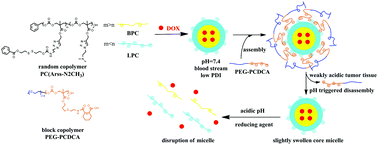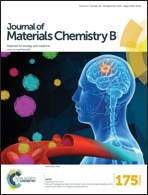Facile construction of near-monodisperse and dual responsive polycarbonate mixed micelles with the ability of pH-induced charge reversal for intracellular delivery of antitumor drugs†
Abstract
A mixed strategy was used to construct size-adjustable, pH and redox dual-responsive, near-monodisperse and charge-conversional core–shell polycarbonate carriers. First, two kinds of random polycarbonates (PC(Arss-N2CH3)) with different ratios of hydrophobic disulfide (Arss) and hydrophilic dimethylamine functional groups (N2CH3) (relatively hydrophobic polycarbonate (BPC) with more disulfide groups and relatively hydrophilic polycarbonate (LPC) with more dimethylamine groups) were used to construct near-monodisperse core micelles in pH 7.4 PBS. Then, a negatively charged shell polymer, poly(ethylene glycol)-b-1,2-dicarboxylic-cyclohexene anhydride modified amino polycarbonate (PEG-PCDCA), bearing acid-labile β-carboxylic amides, was added to the core micelle solution to get the desired mixed micelle. The assembly process, pH induced charge-reversal, and dual-response abilities of the resultant mixed micelles were thoroughly studied using zeta potential and dynamic light scattering (DLS). Two model drugs, Nile red (NR) and doxorubicin (DOX), were successfully loaded into the micelle and could be released in response to dithiothreitol (DTT) and acidic conditions. Confocal microscopy indicated that the micelle system could achieve effective cellular uptake and DOX release in Hela cells. Moreover, the blank micelle and the drug-loaded mixed micelle showed slight and great cytotoxicity against Hela cells, respectively, indicating their significant potential in cancer therapy.


 Please wait while we load your content...
Please wait while we load your content...